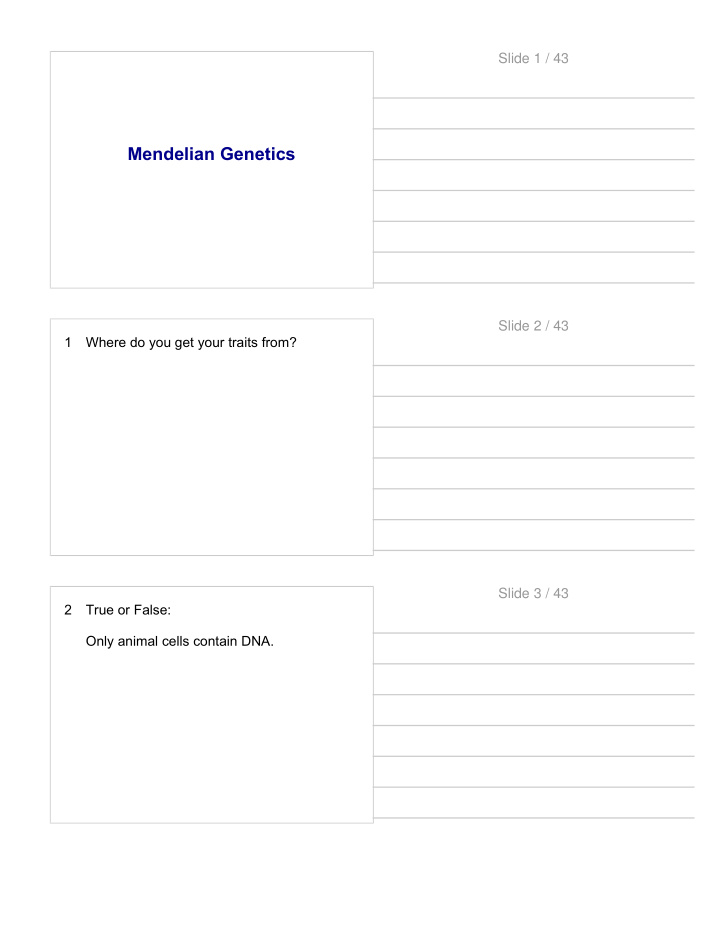



Slide 1 / 43 Mendelian Genetics Slide 2 / 43 1 Where do you get your traits from? Slide 3 / 43 2 True or False: Only animal cells contain DNA.
Slide 4 / 43 3 What is the difference between the products in mitosis and meiosis? Slide 5 / 43 4 One parent is 6' tall. The other is 5' tall. Geneticists predict that each child they have will be 5'6" tall. What hypothesis is represented here? Slide 6 / 43 5 Define the term "phenotype."
Slide 7 / 43 6 In Mendel's experiments, he bred two purple flowers and ended up with some white flowers. How do you think this happened? Slide 8 / 43 7 How many alleles for a trait does an individual get from each parent? Slide 9 / 43 8 Correctly label each of the allele pairs below as either "Homozygous" or "Heterozygous": a) AA b) Aa c) aa
Slide 10 / 43 9 Fill in the following traits for you, your mom, and your dad: Your traits Your Mom's traits Your Dad's traits Hair color Eye color Earlobes (attached or hanging?) Hairline (widow's peak or straight hairline?) Left or right handed? Can roll tongue? Dimples? Freckles/No freckles? Slide 11 / 43 10 Using the information from question #9, do you have more traits in common with your mom or your dad? Why do you think this is? Slide 12 / 43 11 How many pairs of chromosomes do humans have?
Slide 13 / 43 12 In order to swim better, an organism stretches its feet to make them longer. This trait is then passed on to the offspring. What hypothesis is represented here? Slide 14 / 43 13 What characteristics do scientists look for in an organism when they are preparing for an experiment? Slide 15 / 43 14 Define the term "allele."
Slide 16 / 43 Using Punnett Squares Slide 17 / 43 15 Complete the sentence: Human sex cells contain __________ of the DNA of a normal body cell. Slide 18 / 43 16 Pat is getting dressed for school. He has 4 different pairs of sneakers he can wear and 4 different baseball caps. If he wants to choose one of each, how many different combinations can he make?
Slide 19 / 43 17 What type of letter do we use to represent a dominant trait? What type of letter is used for a recessive trait? Slide 20 / 43 18 Define the term "genotype." Slide 21 / 43 19 Does phenotype determine genotype, or is it the other way around?
Slide 22 / 43 20 Cats can either have a curly tail or a straight tail. Curly tails are dominant and are represented by "T." Using this information, write the allele pairs for each of the following: a) A homozygous recessive cat b) A homozygous dominant cat c) A heterozygous cat Slide 23 / 43 21 Use question #20 to answer the following questions: a) What kind of tail does the homozygous recessive cat have? b) What kind of tail does the homozygous dominant cat have? c) What kind of tail does the heterozygous cat have? Slide 24 / 43 22 Set up and complete Punnett Square that crosses a homozygous dominant organism (AA) with a heterozygous organism (Aa).
Slide 25 / 43 23 Use the Punnett Square in question #22 to answer the following questions: a) What percentage of organisms displays the dominant trait? b) What percentage of organisms displays the recessive trait? Slide 26 / 43 24 Why would geneticists use a Punnett Square? Slide 27 / 43 25 Jean wants to do one page of her science workbook and one page of her spelling workbook. There are three pages of science that she can choose from and there are 7 different spelling pages she can do. How many different combinations of workbook pages can she make?
Slide 28 / 43 26 Elizabeth is designing her bedroom. She needs to pick one type of bed, one dresser, and one chair for her room. When she went to the furniture store, she noticed that they had 2 different types of beds, 5 different dressers, and 10 different chairs available. How many different combinations can she make? Slide 29 / 43 27 Correctly label each of the allele pairs. ("Homozygous dominant" "Homozygous recessive" or "Heterozygous") a) Aa b) AA c) aa Slide 30 / 43 28 Set up and complete Punnett Square that crosses a homozygous recessive organism (aa) with a heterozygous organism (Aa).
Slide 31 / 43 29 Use the Punnett Square in question #28 to answer the following questions: a) What percentage of organisms displays the dominant trait? b) What percentage of organisms displays the recessive trait? Slide 32 / 43 Genetic Mutations Slide 33 / 43 30 What are the 4 bases that make up DNA (full names and abbreviations)?
Slide 34 / 43 31 How do the bases always pair up? Slide 35 / 43 32 What is a mutation ? Slide 36 / 43 33 What are three ways in which the environment can cause a mutation to happen in your DNA?
Slide 37 / 43 34 Provide an example (not from our slides) of how a genetic mutation could be helpful to an organism. Slide 38 / 43 35 Where is the DNA found in the cell? Slide 39 / 43 36 What makes up protein?
Slide 40 / 43 37 There are five different types of proteins, each with a different job. Name them and describe each of their jobs. Slide 41 / 43 38 What is the different between an acquired mutation and a hereditary mutation ? Slide 42 / 43 39 Provide an example (not from our notes) of a mutation that would neither really help nor hurt an organism.
Slide 43 / 43 40 What causes Down Syndrome in babies?
Recommend
More recommend